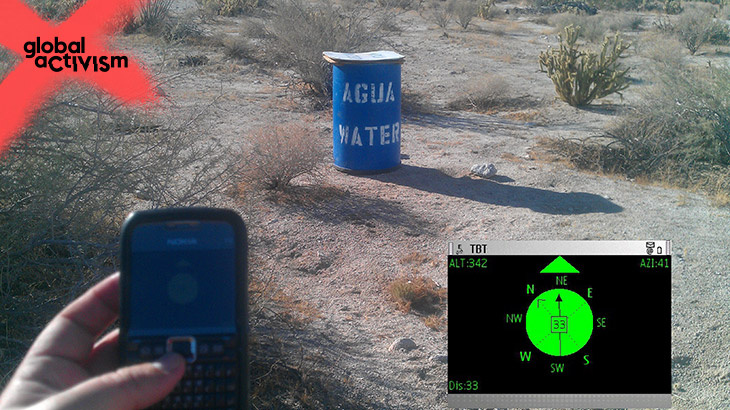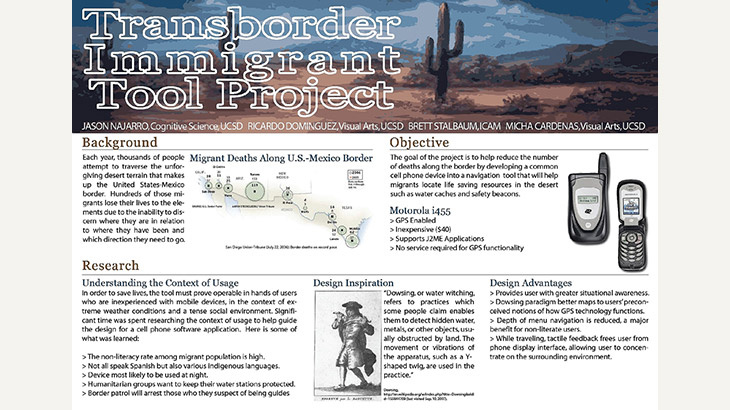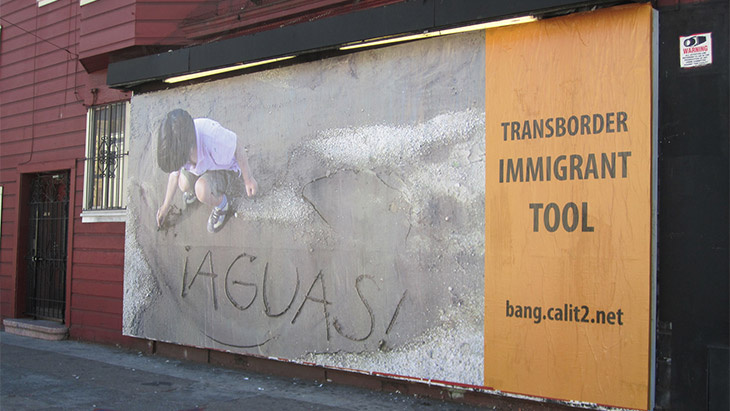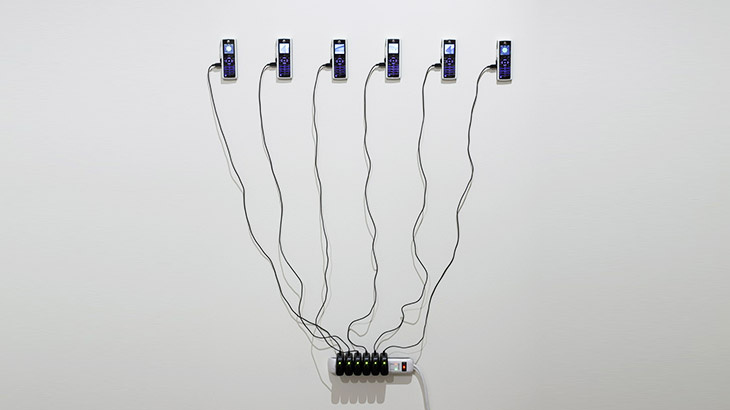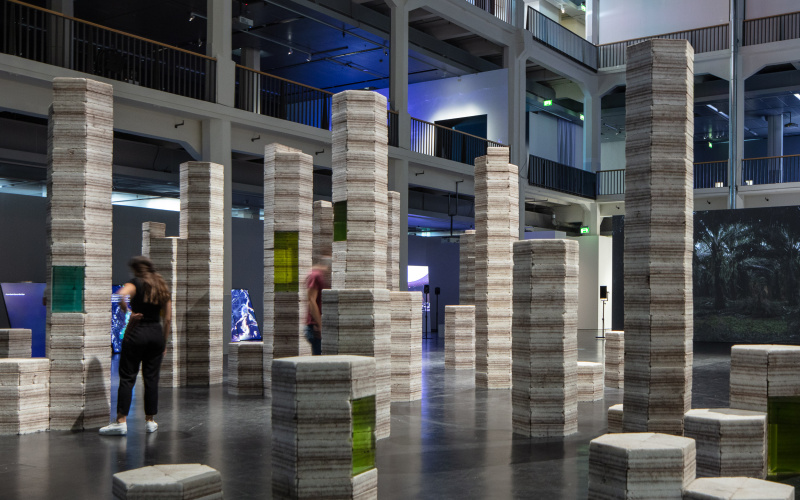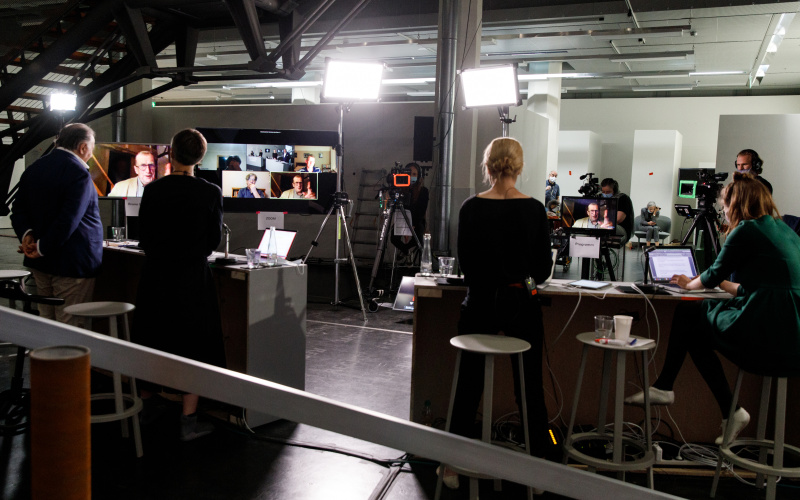Border Art Research: Visible Borders, Invisible People, and the Transborder Immigrant Tool
In 1995 the Border Research and Technology Center (BRTC) was opened; it is operated by Sandia National Laboratories, located in San Diego, California. BRTC works with Homeland Security, the U.S. Customs Service and Border Patrol, the U.S. Attorney offices, and law enforcement agencies to strengthen technology capabilities and awareness on U.S. borders. BRTC also works on joint ventures to identify technologies that will stop the flow of undocumented people crossing the Mexico–U.S. border, and is currently participating in a project to detect heartbeats of people concealed in vehicles or other containers. Nine years later (2004) b.a.n.g lab (stands for bits, atoms, neurons, and genes) in collaboration with Electronic Disturbance Theater 2.0 (EDT) started developing a border art and technology research center at the California Institute for Telecommunications and Information Technology (CALIT2), a $400 million academic research institution jointly run by the University of California, San Diego, and the University of California, Irvine, that would develop a counter-aesthetic and critical technology to disturb the border technologies that programs like BRTC were developing.
In 2007 EDT 2.0/b.a.n.g. lab started developing a mobile-phone technology entitled the Transborder Immigrant Tool (TBT), which provides GPS coordinates and survival poetry to immigrants crossing the U.S.–Mexico border while leading them to water caches in the Southern California desert. In 2010, the project caused a firestorm of controversy on the American political scene, and the artists of EDT 2.0/b.a.n.g. lab (Ricardo Dominguez, cofounder of EDT 1.0/2.0 with new media artist Brett Stalbaum, and new members, artist and theorist Micha Cárdenas, Amy Sara Carroll (poet and border studies scholar at University of Michigan, Ann Arbor), and mixed reality artist Elle Mehrmand), were investigated by three Republican Congressmen, the FBI Office of Cybercrimes, and the University of California, San Diego (UCSD).
TBT began with the basic question: What ubiquitous technology would allow us to create an inexpensive tool to support the finding of water caches left in the Southern California desert by NGOs? Our answer was a cheap iMotorola phone series could be made useful for emergency navigation. The early generation of the platform we targeted can be made reasonably useful in a better-than-nothing scenario. Meanwhile, later phone generations (that don’t yet cross our price barrier, but are getting closer everyday) are already fully useful as practical aids without even a SIM card installed or an available network service. With proper use, the GPS performance of newer phones equals any GPS designed for desert navigation, and their used prices are falling. Moreover, GPS itself does not require service and has free global coverage, courtesy of the United States government. In an emergency scenario, we trust these later mobiles to direct a lost person to a nearby safety site. The TBT’s code is also available online to download at walkingtools.net, sans water cache locations, for any individual or community to use for their GPS investigations.
Part of the history of the Electronic Disturbance Theater 1.0/2.0 and b.a.n.g. lab has been to develop works that can create a performative matrix that activate and take a measure of the current conditions and intensities of power/s, communities, and their anxieties or resistances. So, for us the U.S. Department of Defense launching “info-weapons” at us for a virtual sit-in on September 9th, 1998 or the current confluence of “viral reportage” and the affective contagion of hate about TBT are all part of the performance – of course we would much rather the hate-mail never occurred – dominant media is bad enough to deal with. The aesthetics of working in the zones of postcontemporary “artivist” gestures cannot really escape these types of encounters; it is part and parcel of the patina of our work. But we also feel that the hate-mail or the general fear of losing national purity is coequal in importance with the poetry that they were attacking. In fact, Glenn Beck, an extreme right-wing pundit on the Fox News Channel, attacked not only TBT’s use of poetry, but that the poetry itself had the power to “dissolve” the nation. The performative matrix of TBT allows viral reportage, hate-mail, GPS, poetry, the Mexico–U.S. border, and immigrants to encounter one another in a state of frisson – a frisson that seeks to ask what is sustenance under the sign of globalization-is-borderization and its aesthetics.
Electronic Disturbance Theater 1.0/2.0 has always been invested in experimental poetry as part of its gestures – from the found poetry of the “404 file not found” of our ECD performances in 1990s to the border hack actions with the Zapatista Tribal Port Scan in 2000 on U.S. Border Patrol servers, where we would scan and upload Zapatista poems that we had written into their servers. When we started to develop TBT it became important once again to have a core impulse of the gesture. In 2008 I asked Amy Sara Carroll, who is an experimental poet and scholar at University of Michigan, Ann Arbor – one of the areas of her research is on art and Mexican–U.S. border. She thought that TBT becoming a geo-poetic-system (gps) could expand the frame of experimental poetry and “artivism.” She then began to work with us and established two geo-poetic tracks – one conceptual and the other an echoing of desert survival manuals in multiple languages, which speaks to the multiple borders that are crisscrossing the planet and the multiple languages that are crossing Mexican–U.S. border via immigrants. Here is Amy speaking about TBT:
“[…] my collaboration with Electronic Disturbance Theatre (EDT) on the Transborder Immigrant Tool […] [is] imagined as a global project under development; my own involvement in that ongoing process is linked to the question of what constitutes sustenance in the quotidian of the conceptual, on the varied musical scales of the micro- and macro-. For, often – rightly enough – conversations about crossing the Mexico–U.S. border refer to disorientation, sun exposure, lack of water. The Transborder Immigrant Tool attempts to address those vicissitudes, but also to remember that the aesthetic – freighted with the unbearable weight of ‘love’ – too, sustains. A poetic gesture from its inception, the Transborder Immigrant Tool functions, via the aspirations of such a dislocative medium, as dislocative media, seeking to realize the possibilities of G.P.S. as both a ‘global positioning system,’ and, what in another context Laura Borràs Castanyer and Juan B. Gutiérrez have termed a ‘global poetic system.’ The Transborder Immigrant Tool includes poems for psychic consultation, spoken words of encouragement, and welcome, which I am writing and codesigning in the mindset of Audre Lorde’s pronouncement that ‘poetry is not a luxury.’ […] speaks to the Transborder Immigrant Tool’s overarching commitment to global citizenship. For the excerpt, itself infused with the ‘transversal logic’ of the poetic, acts as one of the Transborder Immigrant Tool’s internal compasses, clarifying the ways and means by which I and my collaborators approach this project as ethically inflected, as transcending the local of (bi-)national politics, of borders and their policing.”
TBT is also a response to the securitization of not only the US–Mexico border, but a critical response to the borderization politics that we are seeing everywhere around the planet. A borderization project that allows the death of hundreds in order to profit from the cheap and necessary labor that is needed to keep the global economies flowing. And since September 11th, 2001, the rapid deployment of bordering, not only at the edges of the nation-state but inside of the nation-states, has been characterized by an increasing biogovernance protocols which systematically connect atavistic emotions of fear and anxiety with technologies of surveillance, where imaginary notions of The Other (immigrants) are targeted as the reason for the global economic and social collapse we find ourselves in. Instead of really seeing that the very conditions of securitization by entities such as the NSA, or the open market flows of undocumented border crossing mega-banks and Wall Street types across the world are at the core of the austerity shocks shuddering across the world.
Text: EDT 2.0/b.a.n.g. lab
Further information on: www.global-activism.de
The Electronic Disturbance Theater (EDT) developed Virtual-Sit-In technologies in 1998 in solidarity with the Zapatista communities in Chiapas, Mexico. Electronic Disturbance Theater’s recent project with Brett Stalbaum, Micha Cárdenas, Dr. Amy Sara Carroll (University of Michigan), and Elle Mehrmand, the Transborder Immigrant Tool (a GPS cellphone safety net tool for crossing the Mexico–U.S border), was the winner of Transnational Communities Award (2008) – an award funded by Cultural Contact, Endowment for Culture Mexico–U.S. and handed out by the U.S. Embassy in Mexico, and also funded by the California Institute for Telecommunications and Information Technology (CALIT2) – as well as two Transborder Awards from the UCSD Center for the Humanities. Transborder Immigrant Tool was exhibited at the 2010 California Biennial (OCMA), Toronto Free Gallery, Canada (2011), as well as a number of other venues around the world. The project was under investigation by the U.S. Congress in 2009/2010, and also reviewed by Glenn Beck in 2010 as a gesture that with its poetry potentially “dissolved” the U.S. border.
Category
News Category
- tracks & records
